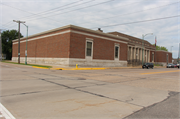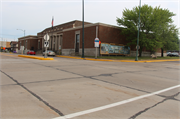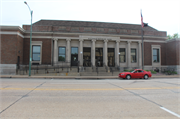| Additional Information: | A 'site file' exists for this property. It contains additional information such as correspondence, newspaper clippings, or historical information. It is a public record and may be viewed in person at the Wisconsin Historical Society, State Historic Preservation Office.
Originally occupied 6/1933.
2017- "The Post Office is located at 320 E. Grand Avenue in the city of Wisconsin Rapids in Wood County. It is situated near the front of an L-shaped lot and faces northeast onto E. Grand Avenue. The building occupies the entire north side of the block. At the rear of the property is a large parking lot that is accessed from Birch Street. A small patch of grass, located on the northwest side of the building, features several trees, a noncontributing modern memorial bench, and a freestanding c.2005 mural illustrating the medical history of Wisconsin Rapids. The Post Office was constructed in two phases: the central portion of the building was constructed in 1933 and designed by James A. Wetmore with Fond du Lac contractor, Immel Construction Company, acting as the builder. The east and west wings were added in 1975 by A.F. Billmeyer & Son.
The building was designed in the Neo-Classical style. It is a two-story, red brick building resting on a raised cut stone foundation and defined water table. The central portion of the building has a hip roof with asphalt shingles and a decorative brick and stone balustrade along the facade roofline. The wings have a flat roof. A simple frieze of stone and red brick follows the roofline and is replicated on the modern wings. Centered on the main (northeast) facade, within the frieze, is a stone plaque that reads: "UNITED STATES POST OFFICE." The facade features a series of seven stone Ionic columns that bracket the four modern glass entrance doors and three, one-over-one, replacement windows. Other windows on the original portion and wings have simple, stone surrounds with Neo-Classical details. The formal concrete stairway leads to the entrance and is flanked by simple decorative light standards with globe lamps. A modern concrete access ramp has been installed on the left (east) side of the stairs. The right (west) side of the stairway includes a simple landscaped space with a flag pole.
The modern wings, which comprise the east and west elevations, have simple, restrained ornamentation similar to that found on the original building. Due to their use for vehicular storage and mail sorting, they lack windows and doors, aside from the sides that face E. Grand Avenue.
The rear (southwest) elevation of the building is simple; the only ornamentation is the frieze that continues around the roofline. At the center is the main, rear entrance with modern, fixed, paired windows. The east wing is dominated by a six-bay loading dock. The west wing has a central garage door bay and is also used to load trucks and vans.
Interior
Access to the interior of the building was granted; however, due to security concerns, photographs were not allowed. The main public area retains original woodwork and flooring, but also features modern, metal mailboxes at the center of the room. At the west end of the public area is a counter for customers. At the rear of the first floor, and not accessible to the public, is a large, open mail sorting area with equipment for moving and sorting mail and packages. Within the modern wings of the buildings are large open spaces for additional sorting, vehicular loading, and storage areas.
Integrity
The Post Office has a relatively high degree of integrity. The modern wing additions, although large, compliment the original style and layout of the Post Office. Although all the windows and doors have been replaced, they generally retain their original openings with the exception of the conversion of one window opening to a door opening on the left side of the facade. According to historic reports and plans, the roof was originally clad in green tile, which has been replaced with modern asphalt shingles, but the roof configuration remains that same. The public spaces of the original portion of the building retain a number of original details such as the flooring, woodwork, and ornamentation.
E. Grand Avenue
Wisconsin Rapids developed from what were two separate communities on either side of the Wisconsin River: Grand Rapids (east bank) and Centralia (west bank). Important local industries included lumber, paper, and pulp production; agriculture, especially dairy and cranberries; and manufacturing and commercial enterprises such as furniture making, breweries, bakeries, grocery, and drug stores. Four separate rail lines served the growing cities, and development centered along the banks of the river. E. Grand Avenue at the southern periphery of the Grand Rapids commercial core experienced both commercial and residential development, as evidenced by the construction of the Wood Block (AHI No. 16741, 132 E. Grand Avenue) and former post office and Elk's Club (AHI No. 16738, 110 E. Grand Avenue). Grand Rapids and Centralia unified in 1900 under the name of Grand Rapids, which officially changed to Wisconsin Rapids in 1920.
A 1919 Sanborn map shows development extending along E. Grand Avenue (then Vine Street) four blocks east of the river; commercial and civic buildings including the former post office, bank, and movie theater clustered toward the west side of the corridor, and residential development stretched east. As of 1922 a new, 500-foot concrete arch bridge (AHI No. 16734, nonextant) was completed along E. Grand Avenue over the Wisconsin River, replacing an older truss bridge and solidifying the roadway's function as a major transportation route connecting the two sides of the unified city. 6 From the 1920s through the Great Depression many of the early frame structures along E. Grand Avenue were replaced with new buildings, such as the Post Office and St. John the Evangelist Episcopal Church (320 Oak Street, AHI No. 16742). The community began to experience an economic boom not long after the United States entered World War II. Local factories fabricated items ranging from aircraft materials to army coats. Combined with the number of returning war veterans, the thriving economy led to a substantial population increase from 11,416 in 1940 to 13,496 in 1950, which created a need for new buildings.
Properly History
The early history of the Wisconsin Rapids postal service is generally unclear; the first post office in Wisconsin Rapids was established in 1845 at an unknown location. Subsequent locations for the postal service are unknown until 1905, when local merchant F.J. Wood constructed a three-story Neo-Classical addition to his 1890s commercial block at 110 E. Grand Avenue. The addition provided space for the local post office on the first floor and additional commercial and social space above (AHI No. 16738, Potentially Eligible).
By early 1930 individual citizen groups began to petition the federal government for a new post office in a new location. Newspapers during this period outline a flurry of activity in order to clear the preferred new site, located along E. Grand Avenue, between 3rd and 4th Streets S. This included the moving of two houses located on the site, which was covered the local newspaper. The City was also able to raise $100,000 to fund the procurement of the preferred new site. In June 1930 the City was named in a Congressional appropriation bill that would provide $125,000 for the purchase of the site and construction of a new post office building, which passed the following year. 13 In June 1931 an unnamed architect from the treasury department, traveled to Wisconsin Rapids to view the site prior to beginning plans for the new building.
The building design and construction contract were announced in December 1931. The Daily Tribune covered the announcement on the front page with the headline: "RECEIVE PLANS OF NEW POST OFFICE: Building to be of Vari-Colored Brick and Limestone, With Large Pillars Adorning Front; Situated on Terraced Lawn, Facing East Grand Ave." This announcement caused a minor uproar; local citizens objected to the use of brick on the facade. Several local groups documented their concerns to the federal government in an official petition demanding: "[W]e request that immediate consideration be given to the changing of the exterior from red brick to stone construction, and the stone used in harmony with the newly constructed church immediately across the street from the post office site (St. John the Evangelist Episcopal Church, AHI No. 16742, Potentially Eligible), and also in harmony with the other public and semi-public buildings in the immediate vicinity." Although the petition was sent to Washington, it was denied due to the potential extra construction costs and the frugality required by the Great Depression.
The following year, Immel Construction Company of Fond du Lac was chosen to provide materials and labor for the building. To assist in the construction, R.G. Bergstrom, a construction engineer from the Office of the Supervising Architect of the Treasury Department, was sent to Wisconsin Rapids for the duration of the construction. The cornerstone was laid on August 1, 1932 (it is no longer visible). Construction was completed in February 1933 and the building opened to the public in March 1933.
In April 1974 the United States Postal Service's communication team announced the Wisconsin Rapids Post Office would be provided $500,000 to $1 million to expand and modernize the subject building. The proposed project would double the size of work room, add a new loading dock and garage for carrier vehicles, and modernize several systems within the building. Bids for the project were opened in March 1975, and called for the construction of two wings that would be added to the historic building and not alter the facade. Local architectural firm A. F. Billmeyer & Son was chosen for the project. The work was completed in February 1976."
-"United States Post Office- Wisconsin Rapids", WisDOT#6999-07-19, Prepared by Mead & Hunt, Inc. (Sebastian Renfield), (2017).
ARCHITECTURAL STATEMENT:
Description: The building is an example of the Neo-Classical style. The plan is irregular with the public entry/lobby on the Grand Avenue face. The original building has been added to both sides and the rear. The side additions extend forward of the original building. The massing materials, and detailing are appropriate to the original and do not detract from it. The rear addition is much more recent (1975) and in a slightly different shade of red brick. The elevation is symmetric about the entry doors. The bulding is constructed of red brick on limestone base. The trim is limestone. The entry is highlighted with smooth limestone columns, approximately 15 feet tall with ionic order capitals. There is a limestone cornice that extends around the perimeter of the building. Above this line and over the mail entrance is found a series of limestone panels into wihich has been carved "United States Post Office." A balustered parapet rises above the cornice line. The windows are dark bronze framed and are not original. The entry stairs and handicap ramp are concrete with painted metal railings.
The interior has the original marble and terrazzo floor. The walls and ceiling are of plaster. The original wood vestibule remains. The building is located on the main highway that travels through the city in the downtown business district.
Significance: The Wisconsin Rapids Post Office with its hipped roof is the most elaborate of three Post Offices surveyed with similar design features. However, massive additions to both sides of the building and to the rear effect the overall significance of the composition. The South Milwaukee version of this design, though without a central hipped roof, is more intact. The building does not appear to meet the criteria of eligibility for listing in the National Register of Historic Places due to the detrimental affect of the addititions to its architectural integrity.
HISTORICAL STATEMENT:
This building is the first federally-owned Post Office building in Wisconsin Rapids. Prior to its construction in 1933, the Post Office in Wisconsin Rapids was located in a variety of locations depending upon who was serving as Postmaster. The first Post Office in Wisconsin Rapids was established in 1845 and E.S. Miner was the Postmaster.
2015 -
The United States Post Office designed by Wisconsin-based architect James A. Wetmore was constructed in 1933. This one-story building is comprised of the original gable roof central core and two 1975 one-story wings with flat roofs on the side (northwest/southeast) elevations and has an irregular plan. It is clad in a combination of brick veneer and cut stone and displays character-defining elements of Neo-Classical architecture, such as the cornice-lined balustrade, frieze, coping, water table, incised panels, and front (east) facade dominated by classical columns. A series of concrete steps and modern Americans with Disabilities Act (ADA) ramp provide access to four modern entrance doors on the front facade. A nameplate with the words “UNITED STATES POST OFFICE” etched into the stone flanked by a floral detail is centered on the facade above the entrance doors. The words “WISCONSIN RAPIDS, WI 54494” appear to have been added between the nameplate and columns. Windows are replacement, one-over-one, double-hung sash with simple stone surrounds.
As a public building, interior access was granted; however, photographs were not permitted. While it appears that some changes were made to the interior, the building retains some original details such as the configuration, wood trim, and interior staircase.
The post office was designed by James A. Wetmore, Supervising Architect for the U.S. Department of Treasury in 1931. Although Wetmore was not an architect, his success was attributed to his ability to work with staff architects by encouraging creativity that complied with the requirements of a standardized design. Throughout the course of his career Wetmore was responsible for the design and construction of more than 2,000 federal government buildings, primarily post offices across the United States (2). |
|---|
| Bibliographic References: | Post office records.
Jones, George O. and Norman S. McVean, HISTORY OF WOOD COURT, WISCONSIN. Minneapolis, 1923, pg. 144-5.
2015
(1) - Robert A. Duchek, “Historic, Architectural & Archaeological Significance Survey for the United States Post Office, Wisconsin Rapids, Wood County, WI,” August 3, 1983, available at the Wisconsin Historical Society Historic Preservation Office, Madison, Wis.
(2) "James Alphonso Wetmore,” Pacific Coast Architecture, http://pcad.lib.washington.edu/person/2001/; Kirk House, “Carved in Stone: The James A. Wetmore Story,” Wellsville Daily Reporter, May 10, 2016, http://www.wellsvilledaily.com/article/20160510/BLOGS/305109998. |
|---|





